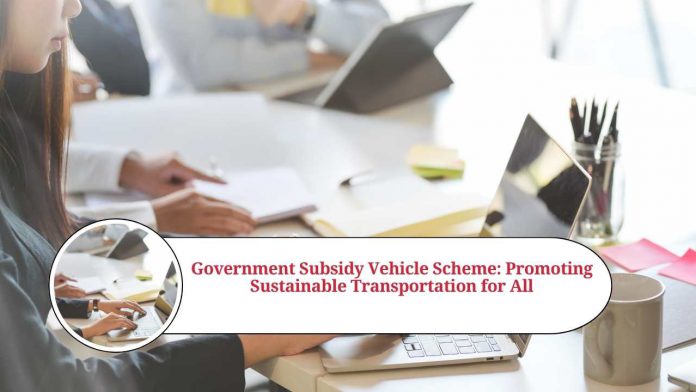The Government Subsidy Vehicle Scheme is an initiative aimed at promoting the adoption of environment-friendly vehicles and ensuring accessible transportation options for individuals. This scheme offers subsidies and incentives to encourage the purchase of electric vehicles (EVs) and other low-emission vehicles. By providing financial support, the government aims to reduce carbon emissions, combat pollution, and create a sustainable transportation ecosystem.
Subsidies for Electric Vehicles (EVs)
Under this scheme, the government provides subsidies for the purchase of electric vehicles. These subsidies significantly reduce the upfront cost of EVs, making them more affordable for consumers. By making electric vehicles financially viable, the government aims to accelerate the transition to clean and sustainable transportation, reducing dependence on fossil fuels and mitigating environmental impact.
Incentives for Low-Emission Vehicles
The Government Subsidy Vehicle Scheme also extends incentives for low-emission vehicles, including hybrid vehicles and vehicles that comply with stringent emission standards. These incentives can include reduced taxes, registration fee waivers, and special concessions. By promoting low-emission vehicles, the government aims to encourage the adoption of cleaner and more fuel-efficient transportation options.
Charging Infrastructure Development
In addition to subsidies and incentives, the government invests in the development of charging infrastructure to support the widespread adoption of electric vehicles. This includes the establishment of public charging stations and the implementation of policies to facilitate the installation of private charging points. By expanding the charging infrastructure network, the government aims to address range anxiety concerns and promote the convenience of owning electric vehicles.
Awareness and Education Campaigns
To create awareness and encourage participation in the subsidy vehicle scheme, the government conducts extensive awareness and education campaigns. These campaigns aim to inform the public about the benefits of electric and low-emission vehicles, dispel myths and misconceptions, and highlight the positive impact on the environment and public health. Through education and outreach, the government strives to create a more sustainable and informed society.
Read more useful content:
FAQs:
Q1: Who is eligible to avail of the government subsidy vehicle scheme?
A1: The eligibility criteria for the government subsidy vehicle scheme may vary depending on the specific guidelines set by the government. Generally, individuals who are residents or citizens of the country and meet the requirements related to vehicle type (e.g., electric or low-emission) and vehicle specifications (e.g., battery capacity, emissions standards) are eligible for the scheme. It is recommended to refer to the official scheme guidelines or consult with the relevant government authorities for accurate eligibility information.
Q2: How can individuals apply for a government subsidy for purchasing a vehicle?
A2: The application process for the government subsidy vehicle scheme typically involves submitting the necessary documents and forms to the designated government department or agency. The application forms are available on the official scheme websites or can be obtained from authorized centers. The required documents may include proof of identity, vehicle specifications, and purchase invoices. It is advisable to follow the application guidelines provided by the government authorities to ensure a smooth and successful application process.
Q3: Is the subsidy applicable only for new vehicles, or can it be availed for used vehicles as well?
A3: The subsidy vehicle scheme primarily focuses on promoting the purchase of new electric vehicles or low-emission vehicles. However, some schemes may also extend benefits to used vehicles that meet certain criteria, such as age, emissions, and technical specifications. It is recommended to refer to the scheme guidelines or consult with the relevant government authorities to understand the eligibility of used vehicles for the subsidy.
Q4: Are there any tax benefits associated with the government subsidy vehicle scheme?
A4: In many cases, the government subsidy vehicle scheme includes tax benefits or exemptions to further incentivize the adoption of electric and low-emission vehicles. These benefits may include reduced taxes, waivers on registration fees, or lower road taxes. The specific tax benefits may vary depending on the jurisdiction and the scheme’s guidelines. It is advisable to consult with tax professionals or refer to the official scheme guidelines to understand the tax-related benefits associated with the subsidy vehicle scheme.
Q5: How can individuals access the charging infrastructure for electric vehicles?
A5: The government typically works in collaboration with public and private entities to establish a widespread charging infrastructure network. Charging stations are installed at strategic locations such as public parking lots, commercial areas, and highways. Individuals can locate charging stations through dedicated mobile applications, online platforms, or electric vehicle charging station directories provided by the government or private entities. The government’s efforts focus on ensuring convenient access to charging facilities for electric vehicle owners.




















